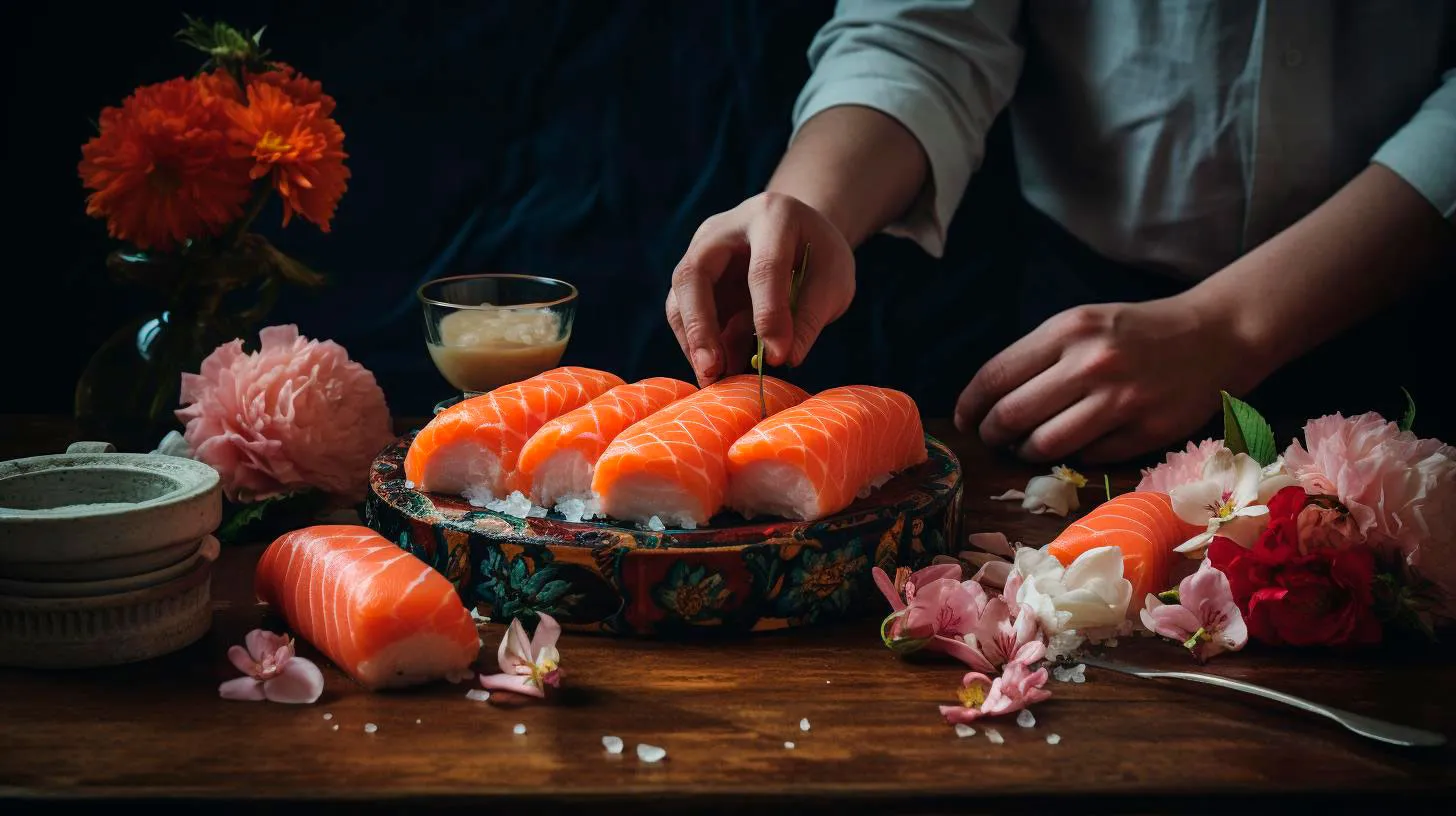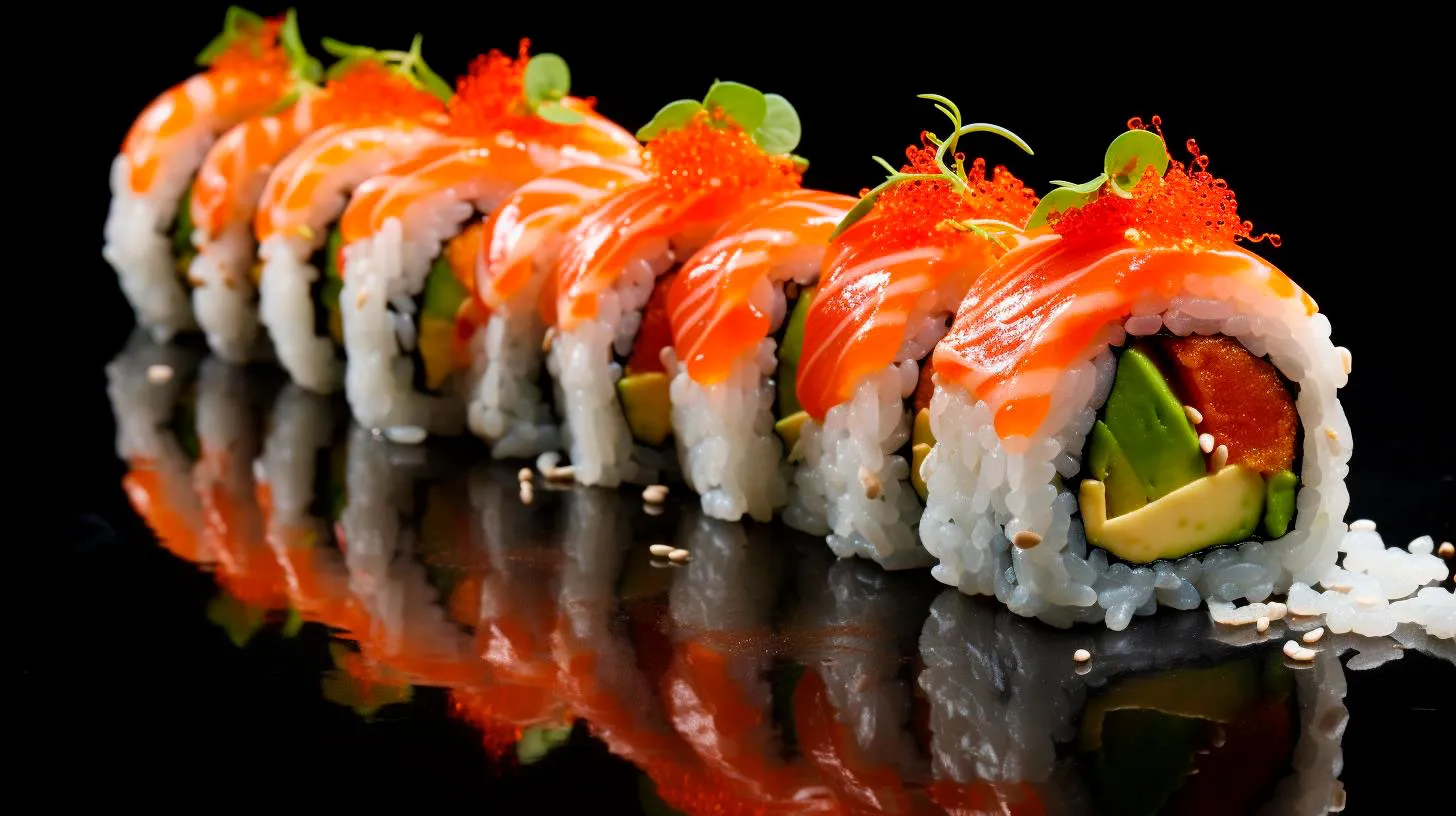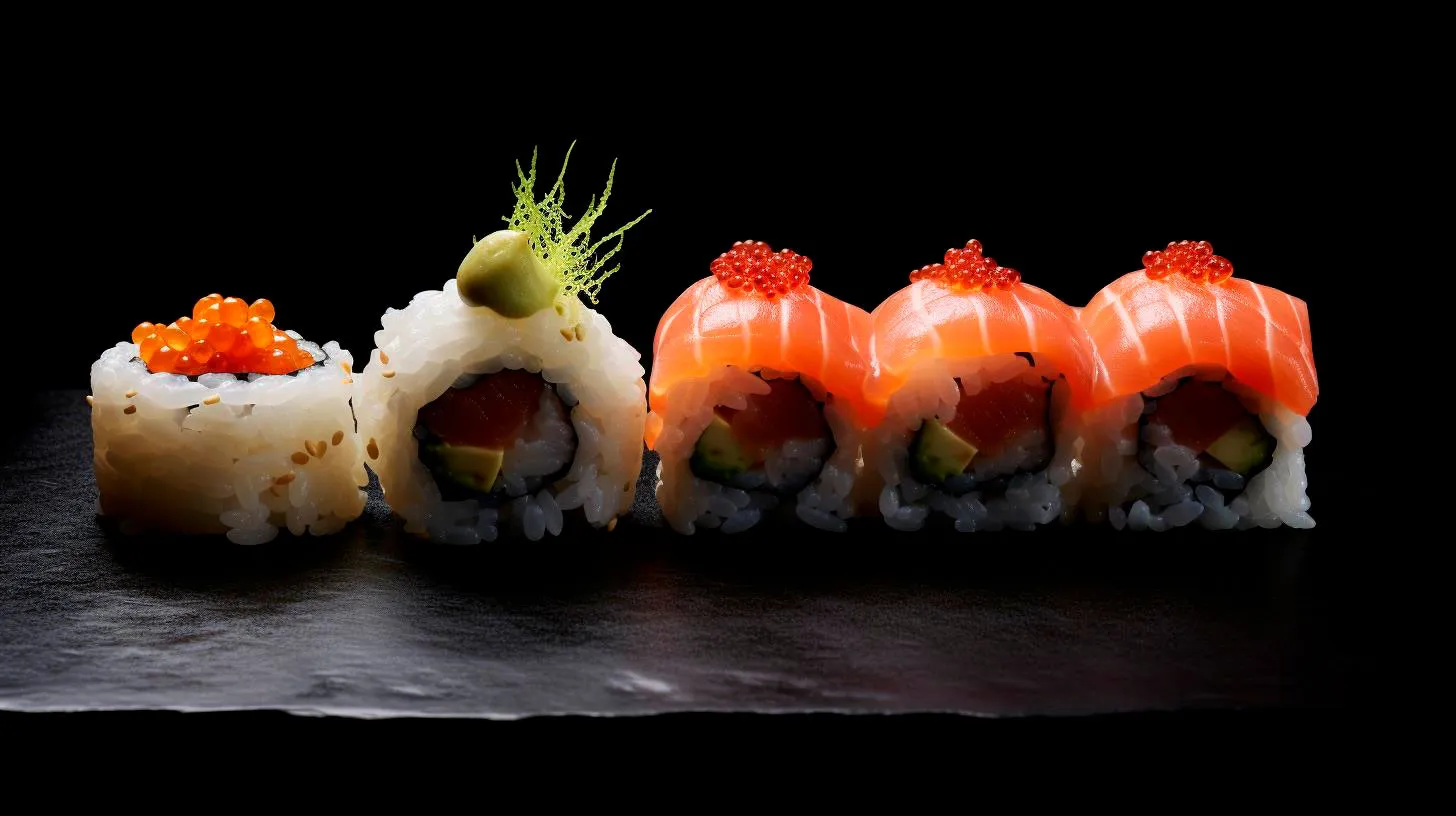Beyond Traditional Borders: A Culinary Adventure in Cross-Cultural Sushi
In this blog post, we will explore the world of cross-cultural sushi, a fascinating culinary phenomenon that blends various cultures, ingredients, and flavors to create a unique and exciting dining experience.
The Fusion of Flavors
Sushi, originally a traditional Japanese dish, has now become a global phenomenon. Chefs around the world, inspired by the art of sushi-making, have taken it upon themselves to experiment, blend, and fuse flavors from different cuisines with the traditional sushi style. Whether it’s incorporating Mexican, Korean, or Indian ingredients, cross-cultural sushi offers an explosion of flavors that transcends borders and tantalizes the taste buds.
Key Takeaways:
- Cross-cultural sushi blends flavors from different cuisines with the traditional sushi style.
- It offers a unique and exciting dining experience that transcends borders.
- The fusion of flavors creates an explosion of taste, appealing to adventurous eaters.
Advantages of Cross-Cultural Sushi
Cross-cultural sushi opens up a world of possibilities for both chefs and diners. It allows chefs to showcase their creativity while staying rooted in the art of sushi-making. By incorporating diverse ingredients and techniques, they can create innovative and visually stunning dishes that awaken the senses.
For diners, cross-cultural sushi offers a chance to experience new flavors and textures that go beyond traditional sushi. It bridges the gap between cultures and introduces an element of surprise and excitement to the dining experience. Moreover, it provides an excellent opportunity to explore various cultural cuisines without leaving the comfort of a sushi bar.
Key Advantages:
- Chefs can showcase their creativity while staying rooted in the art of sushi-making.
- It allows for the creation of visually stunning dishes that awaken the senses.
- Diners can experience new flavors and textures, expanding their culinary horizons.
- It bridges the gap between cultures and offers an element of surprise and excitement.
- Provides an opportunity to explore different cultural cuisines in one place.
Step into the World of Cross-Cultural Sushi
If you’re ready to embark on a culinary adventure and explore the world of cross-cultural sushi, here are a few must-try dishes:
1. Mexican-inspired Sushi:
Combining the vibrant flavors of Mexico with the art of sushi-making, Mexican-inspired sushi rolls are a treat for both the eyes and the taste buds. Imagine a sushi roll filled with avocado, grilled corn, black beans, and a tangy chipotle mayo. It’s a fiesta in every bite!
2. Korean-inspired Sushi:
Korean cuisine is known for its bold flavors and fermented ingredients. When incorporated into sushi, it creates a unique and harmonious fusion. Try a sushi roll filled with marinated bulgogi beef, kimchi, and topped with a spicy gochujang sauce. It’s a perfect balance of sweet, spicy, and tangy.
3. Indian-inspired Sushi:
Indian cuisine is rich in spices and aromas, and it blends beautifully with sushi. A sushi roll filled with fragrant basmati rice, tandoori-spiced chicken, and a cooling raita dip will transport you to the streets of Mumbai in a single bite.
Key Takeaways:
- Mexican-inspired sushi combines vibrant flavors like avocado, grilled corn, and chipotle mayo.
- Korean-inspired sushi incorporates bold flavors from marinated beef, kimchi, and spicy gochujang sauce.
- Indian-inspired sushi blends fragrant basmati rice, tandoori-spiced chicken, and cooling raita dip.
A Global Dining Experience
Cross-cultural sushi has not only revolutionized the world of sushi but has also transformed the dining experience into a global adventure. It brings together people from different cultures and backgrounds, fostering a sense of unity and appreciation for culinary diversity. Exploring cross-cultural sushi allows us to celebrate the fusion of flavors and the beauty of cultural exchange on our plates.
So, the next time you find yourself at a sushi bar, be bold and venture beyond the traditional borders. Explore the exciting world of cross-cultural sushi and savor the delightful blend of flavors that awaits you. It’s a culinary adventure you won’t want to miss!
Global Palette on a Plate: Delighting in the Diverse World of Cross-Cultural Sushi
In this article, we invite you to take a tantalizing journey through the diverse and innovative world of cross-cultural sushi.
Embracing Fusion: The Evolution of Sushi
Sushi has come a long way from its humble beginnings as a simple street food in Japan. As it migrated to different corners of the globe, sushi chefs began experimenting with local ingredients and techniques, resulting in the birth of fusion sushi. This new culinary concept seamlessly blends traditional Japanese flavors with influences from other cuisines, creating a harmonious and mouthwatering marriage of tastes.
Key Takeaway 1: Fusion sushi brings together the best of both worlds by incorporating international flavors into traditional Japanese sushi.
- California Roll: A trailblazer in fusion sushi, the California Roll emerged in Los Angeles during the 1960s. Combining avocado, cucumber, and imitation crab, this roll was a game-changer, appealing to Americans who were initially wary of consuming raw fish.
- Tempura Sushi: By adding a crispy layer of tempura batter to sushi rolls, chefs introduced an exciting new texture and flavor to the dish. Tempura shrimp, sweet potato, or other vegetables are commonly used to create this delightful combination.
- Salsa Sushi: Spicy sushi rolls burst onto the scene by incorporating ingredients like jalapenos, spicy mayo, and chili flakes. Perfect for those who love a little heat, these rolls add a fiery kick to the already exquisite flavors.
The Rise of Vegetarian and Vegan Sushi
As dietary preferences and ethical considerations gained prominence, the sushi world responded with a wide array of vegetarian and vegan options. Today, not only can you find vegetable-filled rolls, but also innovative substitutes for seafood, such as tofu, mushrooms, and even fruit.
Key Takeaway 2: Vegetarian and vegan sushi options cater to the growing demand for plant-based alternatives.
- Avocado Maki: Avocado lovers rejoice! This simple yet delicious roll features creamy avocado slices wrapped in seasoned rice and nori. The smooth and buttery texture of the avocado complements the tangy rice perfectly, making it a popular choice for vegetarians.
- Mushroom Sushi: The umami flavor of mushrooms makes them an excellent substitute for seafood in sushi. Whether it’s the meaty shiitake or the delicate enoki, mushroom sushi offers a unique taste experience that satisfies both vegans and non-vegans alike.
- Fruit Sushi: For those looking for a sweet twist on sushi, fruit sushi is a delightful option. Fresh slices of mango, strawberry, and kiwi are often used as fillings, adding a burst of natural sweetness to each bite.
Sushi Goes Global: Regional Variations
As different cultures adopted sushi, they infused their own influences, resulting in a stunning variety of regional sushi styles. Each variation boasts its own distinctive characteristics and flavor profiles, showcasing the creativity and adaptability of sushi.
Key Takeaway 3: Regional sushi variations provide a unique culinary experience, highlighting the cultural richness of different countries.
- Nigiri Sushi (Japan): The classic sushi form, nigiri, consists of a hand-pressed mound of vinegared rice topped with a slice of fresh fish or seafood. The simplicity and focus on the quality of ingredients make this traditional Japanese style a timeless favorite.
- Gimbap (Korea): Similar to sushi rolls, gimbap features rice, meat, vegetables, and pickled radish wrapped in seaweed. Often enjoyed as a lunchbox staple or picnic snack, the vibrant flavors and hearty fillings make it a beloved Korean treat.
- Ceviche Rolls (Peru): A fusion of Japanese and Peruvian flavors, ceviche rolls showcase the exquisite taste of marinated raw fish combined with colorful vegetables and a hint of spice. The acidity of the lime-infused marinade adds a refreshing zing.
As globalization continues to shape our world, sushi stands as a shining example of how food transcends borders and unites cultures. The artistry, innovation, and adaptability found in cross-cultural sushi truly reflect the diverse tapestry of our global community. So, next time you savor a piece of sushi, remember to appreciate the journey it took to arrive on your plate.
Taste the Fusion Revolution: Exploring Innovative Cross-Cultural Sushi
This article delves into the fascinating world of cross-cultural sushi, highlighting its features, advantages, and key takeaways.
1. Cultural Fusion at Its Finest
With globalization, culinary traditions have traveled across borders, resulting in exciting collaborations and the birth of cross-cultural cuisine. Sushi, traditionally featuring raw fish and vinegared rice, now embraces a variety of ingredients that blend different culinary influences, delivering unexpected and delightful flavors. This fusion revolution allows chefs to craft unique rolls that cater to diverse tastes, making sushi a culinary playground for creativity.
Key Takeaway: Cross-cultural sushi is the result of cultural exchange, embracing traditional and non-traditional ingredients to create new and exciting flavor profiles that cater to diverse palates.
2. Unleashing Creativity
One of the main advantages of cross-cultural sushi is the liberation of creativity it offers to chefs. By using unconventional ingredients and techniques, chefs can break free from traditional boundaries and reimagine sushi in unique and innovative ways. This creativity not only attracts adventurous diners but also allows chefs to leave their mark on the culinary scene.
Key Takeaway: Cross-cultural sushi gives chefs the freedom to experiment, resulting in innovative and enticing flavor combinations that push culinary boundaries.
3. Combining Freshness and Health
Sushi has always been associated with freshness and health, thanks to its emphasis on raw seafood and nutrient-rich ingredients. With cross-cultural sushi, this element is amplified. Chefs incorporate an array of fresh produce, herbs, and spices from various cultures, elevating the nutritional value of sushi rolls. This not only provides a healthier dining option but also adds vibrant colors and exciting textures to the plate.
Key Takeaway: Cross-cultural sushi enhances the health benefits of traditional sushi by incorporating a wide range of fresh ingredients, resulting in a well-balanced and visually appealing dish.
4. Embracing Diversity
One remarkable aspect of cross-cultural sushi is its ability to celebrate diversity. By incorporating ingredients and techniques from different culinary traditions, sushi becomes a representation of cultural exchange and inclusivity. Chefs can create rolls that pay tribute to multiple cultures, making sushi an alluring and inclusive dining experience for people from various backgrounds.
Key Takeaway: Cross-cultural sushi promotes diversity and inclusivity by incorporating ingredients, techniques, and flavors from different culinary traditions, making it an appealing choice for a wide range of diners.
5. Exciting Sushi Variations
The fusion revolution in sushi has resulted in an array of exciting variations, each with its own unique flavors and presentations. Some notable examples include:
- Mexican-inspired sushi: Combining elements of Mexican cuisine like avocados, jalapeños, and chipotle sauce with traditional sushi ingredients for a spicy and flavorful twist.
- Hawaiian-style sushi: Incorporating tropical fruits like pineapple and mango, along with ingredients like macadamia nuts and eel sauce, to create a taste of the islands.
- Indian-flavored sushi: Infusing sushi rolls with aromatic Indian spices like curry powder, turmeric, and cumin for a delightful fusion of flavors.
Key Takeaway: Cross-cultural sushi presents a world of exciting variations, combining flavors and ingredients from different cuisines to create new and enticing sushi experiences.
In Conclusion
The fusion revolution in sushi has opened up a world of culinary possibilities, inviting chefs to unleash their creativity and cater to diverse palates. Cross-cultural sushi is a celebration of culture, diversity, and innovation, offering diners unique and exciting flavor combinations that transcend traditional boundaries. So, embark on a sushi adventure and savor the fusion revolution!



